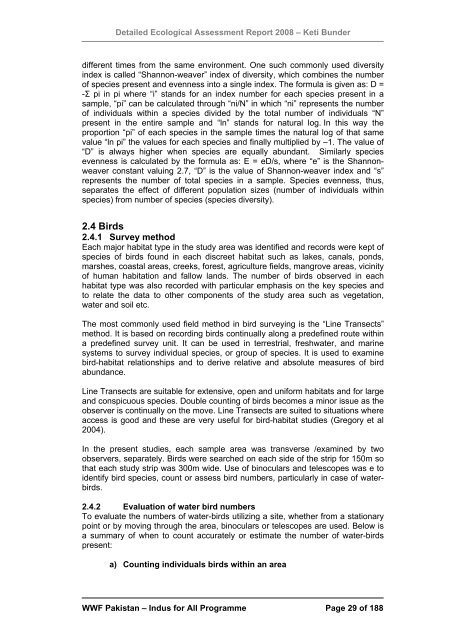Disclaimer note - WWF - Pakistan
Disclaimer note - WWF - Pakistan
Disclaimer note - WWF - Pakistan
Create successful ePaper yourself
Turn your PDF publications into a flip-book with our unique Google optimized e-Paper software.
Detailed Ecological Assessment Report 2008 – Keti Bunder<br />
different times from the same environment. One such commonly used diversity<br />
index is called “Shannon-weaver” index of diversity, which combines the number<br />
of species present and evenness into a single index. The formula is given as: D =<br />
-Σ pi in pi where “i” stands for an index number for each species present in a<br />
sample, “pi” can be calculated through “ni/N” in which “ni” represents the number<br />
of individuals within a species divided by the total number of individuals “N”<br />
present in the entire sample and “ln” stands for natural log. In this way the<br />
proportion “pi” of each species in the sample times the natural log of that same<br />
value “ln pi” the values for each species and finally multiplied by –1. The value of<br />
“D” is always higher when species are equally abundant. Similarly species<br />
evenness is calculated by the formula as: E = eD/s, where “e” is the Shannonweaver<br />
constant valuing 2.7, “D” is the value of Shannon-weaver index and “s”<br />
represents the number of total species in a sample. Species evenness, thus,<br />
separates the effect of different population sizes (number of individuals within<br />
species) from number of species (species diversity).<br />
2.4 Birds<br />
2.4.1 Survey method<br />
Each major habitat type in the study area was identified and records were kept of<br />
species of birds found in each discreet habitat such as lakes, canals, ponds,<br />
marshes, coastal areas, creeks, forest, agriculture fields, mangrove areas, vicinity<br />
of human habitation and fallow lands. The number of birds observed in each<br />
habitat type was also recorded with particular emphasis on the key species and<br />
to relate the data to other components of the study area such as vegetation,<br />
water and soil etc.<br />
The most commonly used field method in bird surveying is the “Line Transects”<br />
method. It is based on recording birds continually along a predefined route within<br />
a predefined survey unit. It can be used in terrestrial, freshwater, and marine<br />
systems to survey individual species, or group of species. It is used to examine<br />
bird-habitat relationships and to derive relative and absolute measures of bird<br />
abundance.<br />
Line Transects are suitable for extensive, open and uniform habitats and for large<br />
and conspicuous species. Double counting of birds becomes a minor issue as the<br />
observer is continually on the move. Line Transects are suited to situations where<br />
access is good and these are very useful for bird-habitat studies (Gregory et al<br />
2004).<br />
In the present studies, each sample area was transverse /examined by two<br />
observers, separately. Birds were searched on each side of the strip for 150m so<br />
that each study strip was 300m wide. Use of binoculars and telescopes was e to<br />
identify bird species, count or assess bird numbers, particularly in case of waterbirds.<br />
2.4.2 Evaluation of water bird numbers<br />
To evaluate the numbers of water-birds utilizing a site, whether from a stationary<br />
point or by moving through the area, binoculars or telescopes are used. Below is<br />
a summary of when to count accurately or estimate the number of water-birds<br />
present:<br />
a) Counting individuals birds within an area<br />
<strong>WWF</strong> <strong>Pakistan</strong> – Indus for All Programme Page 29 of 188

















